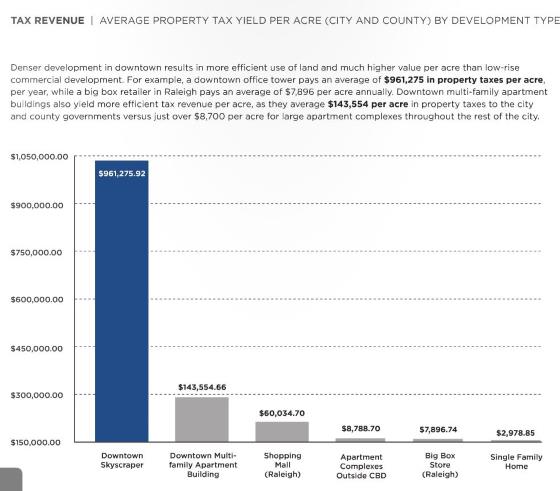Click for larger
You’ve got to have a healthy downtown in order to have a healthy city. This stat taken from the 2016 State of Downtown Raleigh report.
Comments
Comments are disabled here. That's because we're all hanging out on the DTRaleigh Community, an online forum for passionate fans of the Oak City.


“Yes, but…”
Of course, tall buildings are worth more than small buildings on the same footprint. The question is whether all tall buildings will be in downtown. North Hills (and, to a lesser extent, the Strickland-Six Forks focus area) indicate that no, not all tall buildings must be in downtown. If Soleil Center had ever been built, the tallest building in Raleigh would actually be OTB.
Likewise the downtown apartments are marketed primarily to the wealthy, in addition to being built vertically instead of horizontally. No surprise about their value per acre.
I know what you’re trying to say, and I agree with you about a healthy downtown. But the statistics have to be evaluated for what they are.
No mention of the scores of empty lots that occur when developers await their big skyscraper opportunity.
The question is WILL Raleigh ever get a real skyscraper and if so WHEN will it be?
The chart shows averages in a general manner. I agree that seeing the tax yield for retail and office buildings in North Hills versus Downtown high rises and Crabtree retail would be interesting.
@Dana – point well taken but those empty lots downtown already have more tax value than similar empty lots in the suburban parts of the city.
@CX – Key focus areas like North Hills and Crabtree will likely yield more tax revenue based on higher values than other non-CBD areas.
In the end, tax values is only one measure by which we validate supporting a healthy downtown. Quality of life in another. For example, putting skyscrapers in non-walkable areas introduces another layer of issues that affect the daily lives of those occupying the towers and those whose lives happen in the area around them.
Below is an interesting article on where planning for most cities is headed using New York as an example. Height is not as important as it used to be to some planners. Seems like “some ” of the planning Raleigh has undertaken is in line with the most updated planning strategies used today. I don’t profess to be a planning expert by any means but after reading this article I feel Raleigh is headed in the right direction for a city it’s size and where it is in it’s growth/transition.
40 Percent of the Buildings in Manhattan Could Not Be Built Today http://nyti.ms/254zDJX via @UpshotNYT